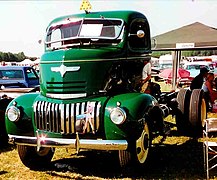Chevrolet AK Series
| 1941–1947 | |
|---|---|
 1946 Chevrolet AK series truck | |
| Overview | |
| Manufacturer | Chevrolet (General Motors) |
| Model years | 1941–1947 |
| Assembly | Baltimore Assembly (Maryland, USA) Flint Truck Assembly (Michigan, USA) Janesville Assembly (Wisconsin, USA) Lakewood Assembly (Georgia, USA) Leeds Assembly (Missouri, USA) Norwood Assembly (Ohio, USA) Oakland Assembly (California, USA) Pontiac West Assembly (Michigan, USA) St. Louis Truck Assembly (Missouri, USA) North Tarrytown Assembly (New York, USA) Oshawa Truck Assembly (Ontario, Canada) GM Argentina, Buenos Aires, Argentina GM Copenhagen[citation needed] |
| Body and chassis | |
| Body style | 2-door pickup truck 3-door panel truck 2-door Cab Over Engine 3-door combination bus 2-door station wagon (Suburban) 2-door Coupe Utility |
| Layout | FR layout |
| Powertrain | |
| Engine | 216 cu in (3.5 L) Chevrolet I6 228 cu in (3.7 L) GMC I6 |
| Transmission | 3-speed manual |
| Chronology | |
| Predecessor | Chevrolet Master trucks |
| Successor | Chevrolet Advance Design |
This article needs additional citations for verification. (November 2015) |
The Chevrolet AK Series was a range of pickup trucks sold under the Chevrolet brand, produced from 1941 through 1947. It used the GM A platform, shared with the Chevrolet Deluxe. The AK series was also branded and sold at GMC locations, with the primary visual difference being the Chevrolet had vertical bars in the grille, while the GMC had horizontal bars. The 1941-45 GMC models were sold as the C-Series and became E-Series for the 1946 and 1947 model years (CC-Series/EC-Series for the conventional cab models and CF-Series/EF-Series for the COE ones).[1]
The AK series represented an appearance split from previous Chevrolet products where the passenger cars and pickup trucks shared a common appearance, as demonstrated in the Chevrolet Master truck. The Chevrolet Deluxe was an all-new appearance when it was introduced in 1941, and shared much of its mechanicals with the third generation Chevrolet Suburban. The truck is considered the second real truck produced by General Motors since trucks preceding the Master trucks were completely car-based, and thus coupe utilities.
It was replaced with the Advance-Design, that was also sold as a GMC.
Gallery[edit]
-
1941 GMC CC-series truck
-
AK series Chevrolet Suburban
-
1942 Chevrolet AK series Cab Over Engine truck
-
Chevrolet AK series bus
See also[edit]
- List of GM platforms
- Dodge T-, V-, W-Series, a contemporaneous American truck series also with Art Deco/Streamline Moderne styling
References[edit]
- ^ "A Brief Outline of the First Century of GMC Truck History". GM Heritage Center. Archived from the original on 10 December 2016. Retrieved 9 July 2015.




